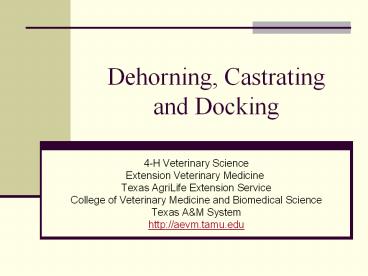Dehorning, Castrating and Docking - PowerPoint PPT Presentation
1 / 25
Title:
Dehorning, Castrating and Docking
Description:
Dehorning, Castrating and Docking 4-H Veterinary Science Extension Veterinary Medicine Texas AgriLife Extension Service College of Veterinary Medicine and Biomedical ... – PowerPoint PPT presentation
Number of Views:236
Avg rating:3.0/5.0
Title: Dehorning, Castrating and Docking
1
Dehorning, Castrating and Docking
- 4-H Veterinary Science
- Extension Veterinary Medicine
- Texas AgriLife Extension Service
- College of Veterinary Medicine and Biomedical
Science - Texas AM System
- http//aevm.tamu.edu
2
Objectives
- Describe dehorning techniques for calves
- Describe castrating techniques for calves, lambs
and pigs - Describe tail docking techniques for lambs
- Discuss benefits of dehorning, castrating and
docking
3
Dehorning
- Dehorning
- The process of removing or preventing the growth
of horns - Benefits
- Improve appearance
- Reduce injuries
- Increase feeder space
- Improve value
- Two methods
- Non-invasive
- Invasive
4
Restraint
- Very important
- Remember safety
- Restrain head
Nose Tongs
Dehorning a Calf
5
Non-Invasive
- Bloodless
- Young animals
- Types
- Chemical paste
- Hot iron
Electronic Horn Budder
6
Invasive
- Blood flow
- Older animals
- Involves cutting or scooping the horn off of the
animals skull - Types
- Barnes dehorner
- Scoop dehorner
7
- Keystone dehorner
8
Dehorning Videos
9
Castrating
- Castration
- The process of removing the testicles from a male
- Benefits
- Prevents mating or fighting
- Improves carcass quality
- Gentles them
- Two methods
- Non-invasive
- Invasive
10
Restraint
- Calves
- On side
- Older bull calves
- In chute
- Young lambs and kids
- On back
- Assistants arms
- V-shaped table
11
Non-invasive
- Bloodless
- Tetanus antitoxin
- Crimps or constricts arteries testicles die
- Young calves or weanlings
- Types
- Burdizzo
- Elastrator
- Calicrate bander
- Short-scrotumed
- Chemical castration
12
- Burdizzo
- Elastrator
13
- Calicrate smart bander
14
Invasive
- Blood flow
- Sanitation is key
- Do not reach into the wound because it could
cause infection - Types
- Knife/scalpel
- Emasculator
15
- Knife
- Scalpel
- Emasculator
16
Calf Castration
- Non-invasive
- Tetanus antitoxin
- Invasive
- Remove 1/3-1/2 scrotum with knife
- Extract testicles
- Sever spermatic cord
- Knife scrape
- Pull
- Emasculator
17
Castration Video
18
Swine Castration
- Invasive
- Make slits on scrotum and tunic
- Knife, scalpel
- Extract testicles
- Sever spermatic cord
- Knife scrape
- Pull
- Emasculator
19
Lamb and Kid Castration
- Non-invasive or invasive
- Tetanus antitoxin
- Same as calves
20
Docking
- Docking
- The practice of cutting the tail off an animal
- Benefits
- Improve appearance
- Increase hygiene (sheep)
- Reduce tail biting (pigs)
- Keep tails out of harnesses (draft horses)
- Two methods
- Non-invasive
- Invasive
- Varies among species
21
Restraint
- Young lambs and pigs
- On back
- Assistants arms
- V-shaped table
22
Non-invasive
- Bloodless
- Types
- Elastrator
- Burdizzo
23
Invasive
- Blood flow
- Sanitation is important
- Types
- Knife
- Scalpel
- Shears
- Emasculator
- Hot, sharp iron
24
Swine Docking
- Cut tail 1 inch from base with a blade
- Dont cut into the base
- Invasive
25
Sheep Docking
- Cut two inches away from base
- Non-invasive
- Invasive
- Tetanus antitoxin































